You’ve come to the right place if you’re new to the world of pressure washing! This comprehensive guide will walk you through a wealth of knowledge about pressure washing, including tools, safety precautions, methods, and priceless advice for getting the best results.
This guide will give you the knowledge and confidence to successfully begin your pressure-washing endeavors, regardless of whether your goal is to revive your driveway, deck, or any other exterior surface.
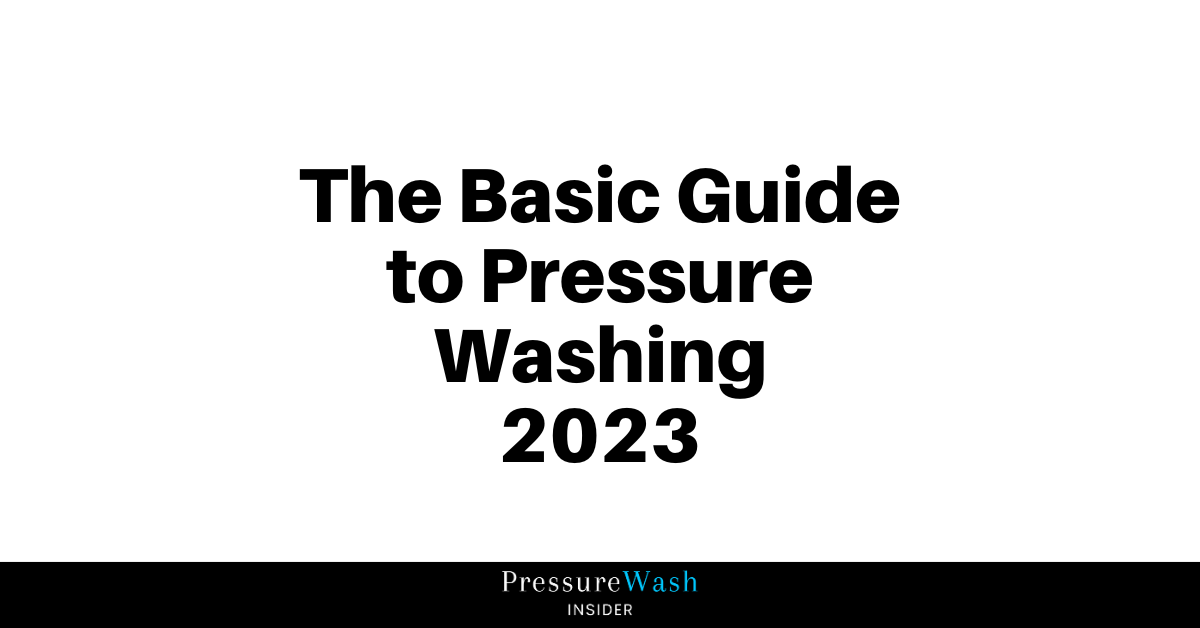
In this Basic Guide To Pressure Washing, you will learn about each and every aspect of pressure washing in a simple and basic way.
What is Pressure Washing?
Pressure washing, or power washing as it is commonly referred to, is a remarkably efficient technique for cleaning. It involves using water under high pressure to effectively eliminate dirt, grime, mold, mildew, and other undesirable substances from a wide range of surfaces.
The global market for pressure washers hit a value of 1.95 billion dollars in 2020. Projections for 2025 anticipate a revenue boost to 2.3 billion, driven by the increasing number of homes and cars worldwide.
Why Should You Consider Pressure Washing?
Pressure washing offers several benefits that make it a popular choice for cleaning outdoor surfaces. There are several compelling reasons to start using pressure washing:
1. Efficiency: Pressure washing is a fast and efficient way to clean large areas in a relatively short amount of time. The high-pressure stream of water can quickly remove dirt and grime, saving you time and effort compared to traditional cleaning methods.
2. Versatility: Pressure washers can be used on a wide range of surfaces, including concrete, brick, wood, vinyl, and metal. Whether you need to clean your driveway, patio, deck, or siding, pressure washing can handle the job effectively.
3. Enhanced Curb Appeal: Regular pressure washing can help restore the appearance of your outdoor surfaces, making them look fresh and well-maintained. It can remove stains, algae, and other unsightly marks, improving the overall curb appeal of your home or property.
4. Preventive Maintenance: By regularly pressure washing your outdoor surfaces, you can prevent the buildup of dirt, mold, and mildew, which can cause long-term damage. Pressure washing can help extend the lifespan of your surfaces, saving you money on costly repairs or replacements.
There are plenty of more benefits of pressure washing.
Choosing the Best Pressure Washer
For best results, the pressure washer you choose is crucial. Think about the following elements:
- Pressure Rating:
One crucial factor to consider when employing pressure washers is their PSI rating, which stands for pounds per square inch. This rating determines the level of pressure generated by the pressure washer during operation. - Flow Rate:
The rate at which water is delivered is determined by the flow rate, which is expressed in gallons per minute (GPM). Greater GPM rates quickly cover larger areas. - Power Source:
Pressure washers are available in electric and gas-powered models. Electric models are quieter, emit no fumes, and require less maintenance. Gas-powered models offer more power but are louder and require more maintenance.
Here are our top picks:
Types of Pressure Washing Equipment
Before you begin pressure washing, it’s important to understand the different types of equipment available. Here are the main components of a typical pressure-washing setup:
- Pressure Washer: The heart of any pressure washing system is the pressure washer itself. These machines come in various sizes and power levels, ranging from small electric models for light-duty tasks to larger gas-powered models for heavy-duty cleaning.
- Nozzles: Pressure washer nozzles play a crucial role in determining the spray pattern and pressure of the water. Different nozzles are designed for specific tasks, such as wide-angle nozzles for general cleaning and narrow-angle nozzles for stubborn stains.
- Hoses: Pressure washer hoses connect the pressure washer to the water supply and allow the high-pressure water to reach the nozzle. It’s important to choose a hose that is compatible with your pressure washer and can withstand water pressure.
- Detergents: In some cases, you may need to use cleaning detergents or chemicals to tackle tough stains or specific cleaning tasks. Pressure washer detergent tanks or downstream injectors can be used to apply the cleaning solution to the surface.
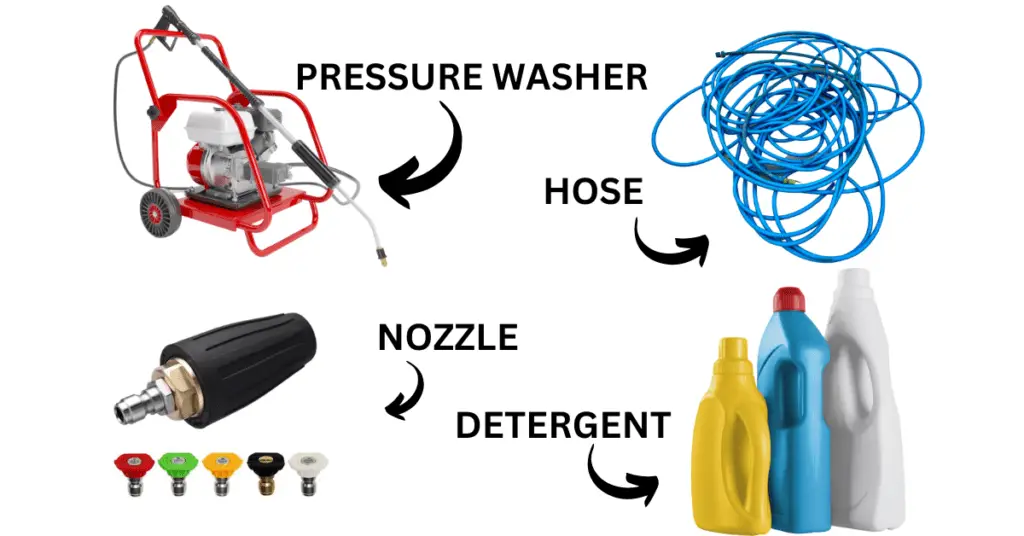
Safety First: Precautions Before You Begin
While pressure washing is generally safe when done correctly, it’s important to take certain precautions to protect yourself, others, and the surfaces you’re cleaning. Here are some safety tips to keep in mind:
- Wear Protective Gear: Always wear safety goggles, gloves, long sleeves, and closed-toe shoes to protect yourself from debris, chemicals, and high-pressure water.
- Inspect the Area: Before you begin pressure washing, inspect the area for any loose or damaged objects that could be dislodged by the force of the water. Secure or remove any items that could pose a risk.
- Protect Nearby Plants and Objects: Cover delicate plants, electrical outlets, and other sensitive objects near the cleaning area with plastic sheeting or tarps to prevent damage.
- Avoid Electrocution: Be cautious of electrical hazards. Keep the pressure washer away from electrical outlets or power lines, and never operate the machine while standing in water or on a wet surface.
- Use Proper Technique: Hold the pressure washer nozzle at a 45-degree angle to the surface and maintain a consistent distance to avoid causing damage. Start with low pressure and gradually increase as needed.
For essential safety guidelines and recommendations regarding the use of pressure washers, the Centers for Disease Control and Prevention (CDC) offers a comprehensive resource at CDC Pressure Washer Safety.
Getting Started: Step-by-Step Guide to Pressure Washing
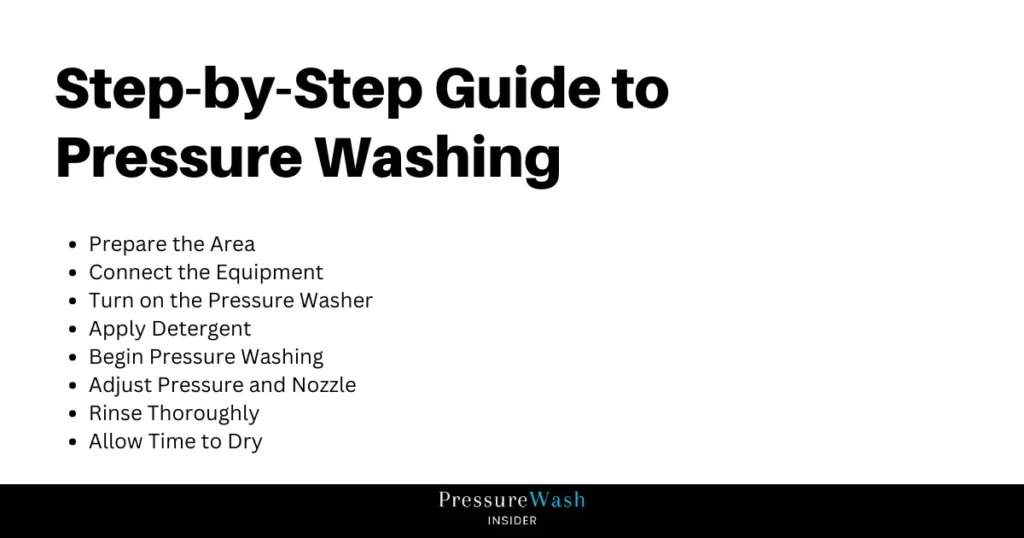
Now that you’re familiar with the basics and safety precautions, let’s dive into the step-by-step process of pressure washing:
1. Prepare The Area

Remove any loose debris, furniture, or obstacles from the area you plan to pressure wash. Sweep the surface to eliminate loose dirt and debris.
2. Connect the Equipment

Attach the hose to the pressure washer and connect the other end to a water source with sufficient water flow. Make sure all connections are secure.
3. Turn on the Pressure Washer

Start the pressure washer according to the manufacturer’s instructions. It is essential to yourself used to the controls and settings of the pressure washer you are using to ensure safe and effective operation.
4. Apply Detergent (If Needed)
If you’re using a cleaning detergent, follow the manufacturer’s instructions to mix the appropriate amount with water. Use the detergent application setting on your pressure washer to apply the solution evenly to the surface.
5. Begin Pressure Washing
Hold the pressure washer wand at a 45-degree angle and start washing from the top down. Move the wand in even, overlapping strokes to ensure consistent coverage.
6. Adjust Pressure and Nozzle
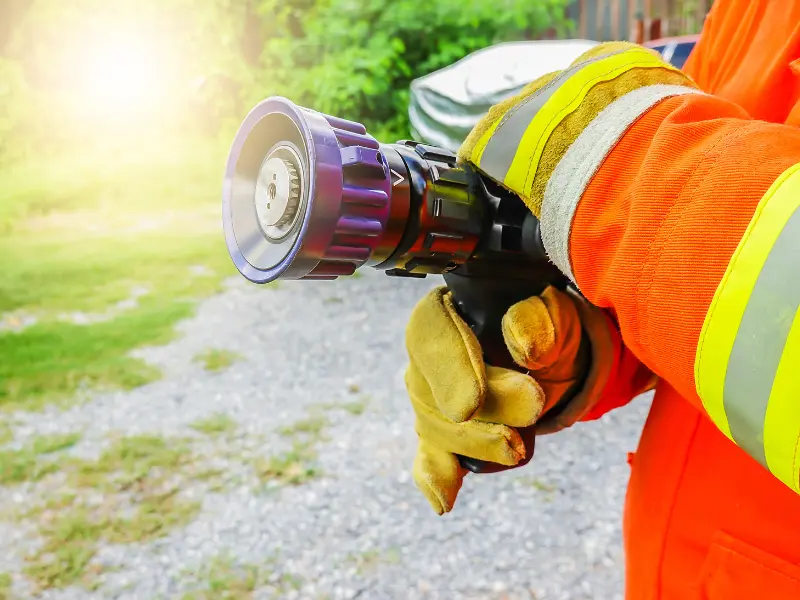
Depending on the surface and cleaning requirements, you may need to adjust the pressure and nozzle. Test different settings on a small, inconspicuous area before proceeding.
7. Rinse Thoroughly
Once you’ve finished pressure washing, rinse the surface thoroughly with clean water to remove any remaining detergent or debris.
8. Time to Dry
Give the cleaned surface ample time to dry before using or walking on it. This will prevent slips and falls
Pressure Washing Techniques for Different Surfaces
Different surfaces require different pressure washing techniques to achieve optimal results without causing damage. Here are some recommended techniques for common surfaces:
- Concrete: Use a high-pressure setting with a narrow-angle nozzle to remove stains, dirt, and mildew from concrete surfaces. Move the wand slowly and evenly to avoid etching or gouging the concrete.
- Wood: Lower the pressure and use a wider-angle nozzle to prevent damage to wood surfaces. Keep the wand moving to avoid saturating the wood, which can lead to warping or splitting.
- Brick: Start with a lower pressure setting and a wider-angle nozzle to prevent chipping or dislodging mortar. Gradually increase pressure if necessary, but be cautious to avoid damaging the bricks.
- Vinyl or Siding: Use a wide-angle nozzle and medium pressure to clean vinyl or siding surfaces. Maintain a consistent distance to prevent warping or puncturing the material.
- Metal: For metal surfaces, use a narrow-angle nozzle and moderate pressure to remove rust, grime, or paint. Be careful not to apply excessive pressure, as it can cause dents or scratches.
Remember, always test a small, inconspicuous area before pressure washing the entire surface to ensure that your technique and pressure settings are appropriate. To know more about the surfaces that can be cleaned with a pressure washer. Read this article: Things That Are Safe To Pressure Wash
Best Practices for Effective Pressure Washing
To achieve the best possible results and avoid common pitfalls, here are some best practices to keep in mind:
Start with Low Pressure: Begin with the lowest pressure setting and gradually increase as needed. Starting with high pressure right away can cause damage to the surface.
Maintain a Consistent Distance: Keep the nozzle at a consistent distance from the surface throughout the cleaning process. This ensures even cleaning and prevents damage from concentrated pressure.
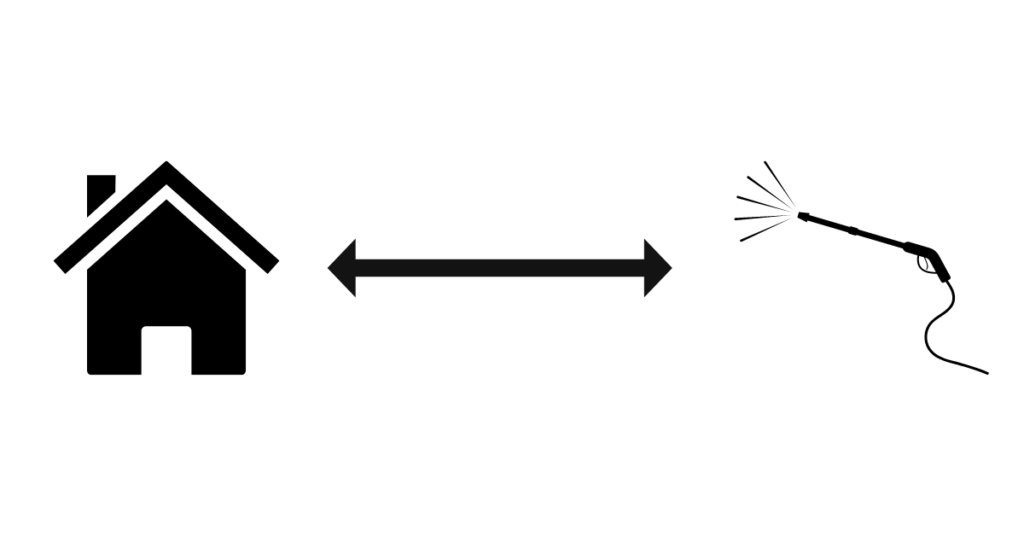
Work in Sections: Divide large areas into smaller sections and clean them one at a time. This helps you maintain control over the cleaning process and ensures thorough coverage.
Overlap Strokes: Overlapping each stroke by about 50% ensures even cleaning and avoids leaving streaks or patches of dirt.
Clean Gutters and Downspouts: Use an appropriate attachment or accessory to clean gutters and downspouts, removing leaves, debris, and other obstructions.

Clean from Bottom to Top: When cleaning vertical surfaces, such as siding or walls, start from the bottom and work your way up. This prevents dirty water from streaking down and causing further staining.
Tips and Tricks for Optimal Results
To take your pressure washing skills to the next level, here are some tips and tricks that can help you achieve optimal results:
- Pre-Soak for Tough Stains: For stubborn stains or heavily soiled areas, pre-soak the surface with a suitable cleaning solution before pressure washing. This helps loosen the dirt and makes the cleaning process more effective.
- Use Hot Water: If your pressure washer has a hot water option, utilize it for greasy or oily stains. Hot water can dissolve and remove such substances more effectively than cold water alone.
- Work with the Grain: When pressure washing wooden surfaces, such as decks or fences, work with the grain of the wood to avoid damaging the fibers.
- Clean in the Shade: Whenever possible, choose a cloudy or cooler day to pressure wash. Cleaning in direct sunlight can cause the cleaning solution to penetrate the surface too quickly, reducing its effectiveness.
- Protect Windows and Delicate Surfaces: Cover windows and delicate surfaces, such as glass or painted areas, with plastic or tape before pressure washing nearby. This prevents accidental damage from high-pressure water or cleaning solutions.
- Inspect and Repair: Before pressure washing, inspect the surface for any cracks, loose paint, or damage. Repair these issues before cleaning to avoid exacerbating the problem.
- Practice Patience: Allow enough time for the cleaning solution to work on tough stains or dirt buildup. Sometimes, letting it sit for a few minutes before pressure washing can significantly improve the results.
- Follow the Manufacturer’s Instructions: Always refer to the manufacturer’s instructions for your specific pressure washer model. Each machine may have unique features or requirements that you need to be aware of for safe and effective operation.
- Protect Yourself from Recoil: Pressure washers can have a strong recoil when you release the trigger. To avoid injury, maintain a firm grip on the wand and be prepared for the sudden force.
- Clean in Well-Ventilated Areas: If you’re using cleaning solutions or detergents, make sure you’re working in a well-ventilated area to prevent inhaling any fumes. If necessary, use a respirator or mask for added protection.



By implementing these tips and tricks, you can maximize the effectiveness of your pressure-washing efforts and achieve outstanding results on a variety of surfaces.
Common Mistakes to Avoid
While pressure washing can be a straightforward process, there are a few common mistakes that beginners should be aware of to prevent potential damage or accidents. Here are some mistakes to avoid:
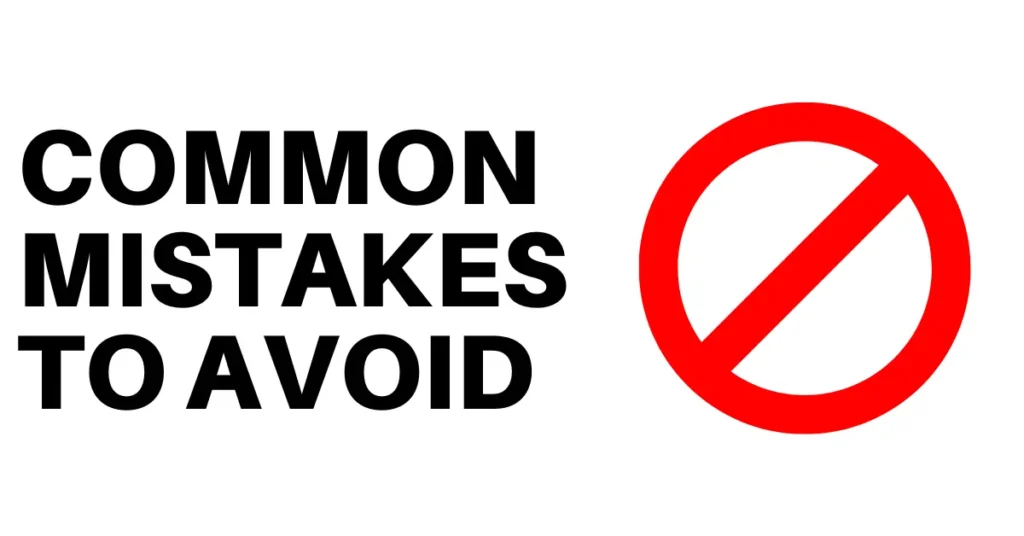
- Using Excessive Pressure: Applying too much pressure can cause damage to surfaces, including etching concrete, stripping paint, or denting delicate materials. Start with low pressure and gradually increase if necessary.
- Ignoring Safety Precautions: Neglecting safety gear, such as goggles, gloves, or proper footwear, can put you at risk of injury. Always prioritize safety and use the necessary protective equipment.
- Cleaning Too Close: Holding the nozzle too close to the surface can result in gouging, etching, or stripping. Maintain a safe and consistent distance to avoid unintended damage.
- Using Incorrect Nozzle or Pressure Setting: Different surfaces and cleaning tasks require specific nozzle types and pressure settings. Using the wrong nozzle or pressure can lead to ineffective cleaning or surface damage. Take a look at the manufacturer’s recommendations for guidance.
- Skipping Pre-Cleaning Preparation: Failing to remove loose debris, furniture, or obstacles before pressure washing can cause damage or result in an uneven cleaning. Take the time to prepare the area properly before starting.
- Overusing Cleaning Chemicals: While cleaning solutions can be beneficial for tough stains, using excessive amounts or leaving them on the surface for too long can lead to discoloration or damage. Follow the instructions provided by the manufacturer for the proper application and rinsing of cleaning solutions.
By avoiding these common mistakes, you’ll be able to achieve better results and maintain the integrity of the surfaces you’re cleaning.
Cleaning Solutions: What to Use and When
Cleaning solutions can enhance the effectiveness of pressure washing, especially when dealing with stubborn stains or specific cleaning tasks. Here are some common cleaning solutions and their recommended uses:
- All-Purpose Cleaners: All-purpose cleaners are suitable for the general cleaning of outdoor surfaces like decks, patios, and driveways. They are effective in removing dirt, grime, and mildew. Ensure the cleaner is compatible with your pressure washer and follow the manufacturer’s instructions for dilution ratios.
- Degreasers: Degreasers are designed to remove oil, grease, and other stubborn stains from surfaces such as driveways, garage floors, and outdoor cooking areas. They are particularly useful for removing automotive grease or oil stains. Check the product label for compatibility with pressure washers and follow the instructions for proper dilution and application.
- Mold and Mildew Cleaners: Mold and mildew cleaners are formulated to eliminate and prevent the growth of mold, mildew, and algae. They are commonly used on surfaces like vinyl siding, decks, and fences. Read the manufacturer’s instructions for effective use.
- Concrete Cleaners: Concrete cleaners are specifically designed to tackle tough stains, such as rust, oil, and tire marks, on concrete surfaces. They are highly effective in restoring the appearance of driveways, sidewalks, and patios. Refer to the manufacturer’s recommendations for dilution ratios and application methods.
- Wood Cleaners: Wood cleaners are gentle solutions that effectively clean and brighten wooden surfaces like decks, fences, and furniture. They remove dirt, grime, and mildew without causing damage or discoloration to the wood. Be sure to choose a cleaner specifically formulated for wood and follow the instructions for the best results.
- Specialty Cleaners: Some surfaces or stains may require specialty cleaners, such as rust removers, graffiti removers, or specific surface cleaners. These products are formulated for specific cleaning tasks and should be used according to the manufacturer’s instructions.
Always remember to test the cleaning solution on a small, inconspicuous area before applying it to the entire surface. This ensures that the cleaner is compatible and doesn’t cause any undesirable effects.
To learn more about DIY Cleaning Solutions, click here.
Frequently Asked Questions (FAQs)
What are the basics of power washing?
The basics of power washing involve using high-pressure water to clean surfaces, such as buildings, driveways, and vehicles.
What PSI should I use for pressure washing?
The PSI (pounds per square inch) you should use for pressure washing depends on the surface you’re cleaning. Generally, for residential use, a PSI between 1,300 and 2,400 is recommended.
What chemicals are best for pressure washing?
The best chemicals for pressure washing depend on the specific cleaning task. Common options include detergents, degreasers, and mildew removers. Always follow manufacturer instructions and use appropriate safety precautions.
What should be the ratio of soap to water on a pressure washer?
The ratio of soap to water on a pressure washer can vary depending on the cleaning solution and the manufacturer’s instructions. It’s best to refer to the product label or consult the pressure washer’s manual for the recommended ratio.
What is the power wash flow rate?
Power wash flow rate refers to the volume of water that a power washer can deliver per minute. It is typically measured in gallons per minute (GPM) and can affect cleaning efficiency and speed.
What are the four methods of washing?
The four methods of washing are: a. Pressure washing: Using high-pressure water to clean surfaces. b. Soft washing: Applying cleaning solutions and using low-pressure water for delicate surfaces or areas prone to damage. c. Power scrubbing: Using a rotating brush or scrubber attachment to agitate and remove dirt. d. Steam cleaning: Utilizing high-temperature steam to sanitize and clean surfaces.
Conclusion
Pressure washing is a powerful and efficient method for cleaning a wide range of outdoor surfaces. By reading this Basic Guide to Pressure Washing, understanding the basics of pressure washing, and following best practices, you can achieve excellent results while maintaining the integrity of the surfaces you’re cleaning.
Remember to select the appropriate pressure setting, nozzle, and cleaning solution for each specific task. Take safety precautions, avoid common mistakes, and always test a small area before tackling larger surfaces.
Whether you’re cleaning your driveway, siding, deck, or any other outdoor area, pressure washing can rejuvenate the appearance and restore the cleanliness of your property. So grab your pressure washer, put on your safety gear, and get ready to make your outdoor spaces shine!


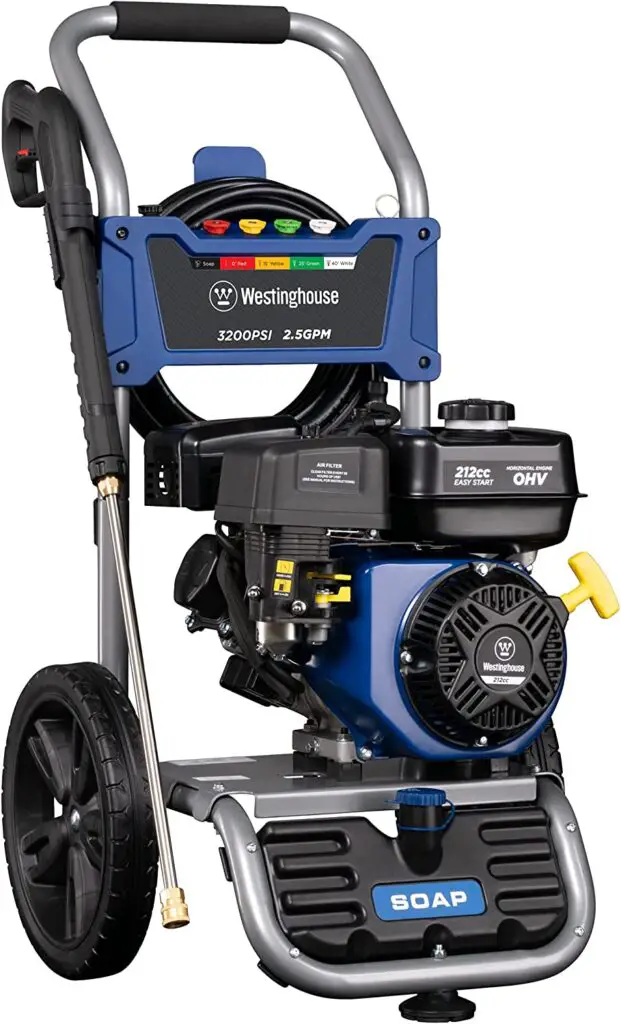

14 thoughts on “The Basic Guide to Pressure Washing”
👍🏻
Admiring the commitment you put into your blog and in depth information you
present. It’s awesome to come across a blog every once in a while that
isn’t the same unwanted rehashed material.
Great read! I’ve saved your site and I’m including
your RSS feeds to my Google account.
Hello there! I know this is kinda off topic nevertheless I’d
figured I’d ask. Would you be interested in exchanging
links or maybe guest authoring a blog article or vice-versa?
My website covers a lot of the same topics as yours and I believe we could greatly benefit from
each other. If you happen to be interested feel free
to send me an email. I look forward to hearing from you!
Excellent blog by the way!
Wow, that’s what I was searching for, what a material!
existing here at this website, thanks admin of this web page.
I was recommended this website by means of my cousin. I’m no longer
sure whether or not this put up is written by means of him
as nobody else recognize such detailed approximately my trouble.
You are incredible! Thank you!
certainly like your web site however you have to check the spelling on several of your posts.
Many of them are rife with spelling issues and I find it very
troublesome to tell the reality nevertheless I’ll certainly
come back again.
My brother suggested I might like this blog. He was totally right.
This publish actually made my day. You can not consider just how much time I had spent for this info!
Thank you!
Keep this going please, great job!
I will right away grab your rss as I can not to find your e-mail subscription link or
newsletter service. Do you’ve any? Kindly allow me
understand in order that I may just subscribe.
Thanks.
Hello There. I discovered your weblog using msn. This is a really neatly written article.
I will be sure to bookmark it and come back to read extra of
your helpful information. Thank you for the post.
I’ll certainly return.
Hi, this weekend is good for me, because this moment i am reading this great educational article here at my home.
Hi there! This post couldn’t be written any better!
Going through this post reminds me of my previous roommate!
He always kept preaching about this. I am going to forward this article to him.
Fairly certain he’s going to have a great read. Thanks for sharing!
Great blog right here! Also your web site a lot up fast! What web host are you using?
Can I get your affiliate hyperlink for your
host? I wish my website loaded up as quickly as yours lol